PHOTOGRAPHING AUSTRALIA'S HAUNTED LANDSCAPES
By Coral Hull
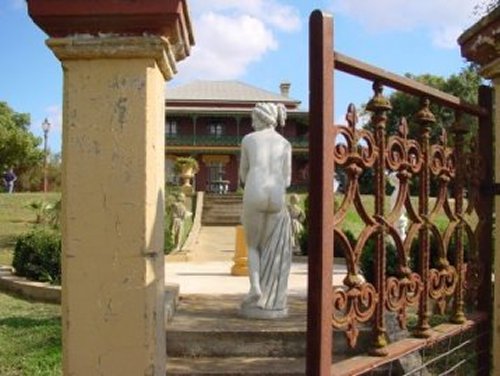
[Above] Monte Cristo Historic Homestead, Junee, New South Wales, Australia (Photo by Coral Hull, 2001)
Most of human and non-human physiology and psychology remains unknown. Most animal and plant species living on planet earth remain unknown and therefore unrecorded. What lies beyond planet earth, the solar system, the milky way galaxy and the universe itself remains almost completely unknown. At best all of the above live within the realms of theory and continuing investigation. The perception of a human being is limited. The further we investigate subject matter the more unknowable it becomes. Therefore it is no surprise that people are attracted to one of the most physically available and yet unknowable ecologies in the world, and that is the ecology of the haunted landscape.
Monte Cristo is a colonial mansion built in 1884. The property was purchased by its present owners Reg and Olive Ryan in 1963. Reg Ryan believed that he was always meant to be the owner and, more importantly, the caretaker of the magnificent homestead up on a prominent hill that overlooks the town of Junee in New South Wales, Australia. Monte Cristo (meaning Mount of Christ) is recognized as the most haunted house in Australia. The homestead has been featured in many books and television programs such as A Big Country, The Extraordinary and more recently as a venue of Scream Test. I was first attracted to photograph Monte Cristo after watching a segment on Scream Test and then by further reading on the homestead at the Australian Ghost Hunters' Society website and in The Ghost Guide To Australia by Richard Davis. From my reading I deduced that each of Australia's haunted places are unique in both their geographical location, cultural characteristics and most importantly their historical significance. The 'history' is the making of 'the haunting' in Australia and Monte Cristo has a colourful, brutal and often macabre history surrounding this homestead.
The Monte Cristo homestead was my fifth venture into a well-known haunted landscape. After visiting the somewhat sombre atmosphere of Port Arthur in Tasmania twice and then Sydney's Hyde Park Barracks and spooky Quarantine Station, my interest in and attraction to these haunted environments began to emerge. It now appears to be operating on a number of levels, as I believe is the actual 'supernatural' landscape itself. As a writer and in particular a photographer of landscape, I am interested in exploring what makes a 'regular' landscape into a 'haunted' landscape? Or alternatively what makes a presumed landscape into something more than itself? All landscapes have a psychic history, so are all landscapes haunted? Do hauntings go in and out of existence? What causes a haunting and what effect does this have on the psyche of those who visit such a place? What effect will it have on me? Will photographing a haunted landscape bring about an awareness that doesn't normally exist with photographing a regular landscape? As part of my initial research I found out that a haunted landscape may possess a series of similar characteristics that have no explanation, and yet seem to be orientated towards the human rather than the non-human psyche.
My observations on haunted landscapes in Australia are currently as follows:
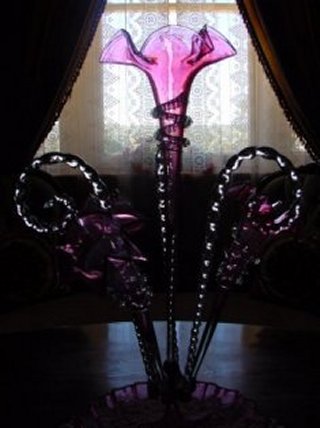
|
1. A alleged haunted landscape involving paranormal activity often has a dramatic or emotional human history that may involve one incident or a continuing series of incidents that occurred during the past.
2. A haunted landscape may have either one or multiple layers of paranormal activity that whilst occurring simultaneously seem entirely unrelated.
3. Paranormal activity may follow a witness from one environment to another. A well documented example of this occurring is when tourists who visit Port Arthur (one of Australia's most notorious penal colonies situated in Tasmania) see convicts sitting in the back seats of their cars when looking into the rear vision mirror, either when in the carpark or driving away from the site or as in the case of poltergeists.
4. Paranormal activity mainly occurs during the night rather than during the day.
5. Paranormal activity may be associated with reccurring weather conditions such as a storm.
6. It may also occur within regards to dates of significane to humans such as an anniversary, a death or a birthday. |
[Above] The Sitting Room, Monte Cristo Historic Homestead, Junee, New South Wales, Australia (Photo by Coral Hull, 2001)
7. When inside houses or other buildngs much paranormal activity occurs in hallways, on stairways or in bedrooms.
8. A majority of paranormal activity is witnessed by a person who is either in bed, upon sleeping or waking with the manifestation either appearing in the room and/or the end of the bed or touching the person, which may suggest lucid dreaming or a hypnogogic experience.
9. General hauntings and including haunted areas or specific manifestations within those areas are primarily human egocentric and involve human history, interaction and psychology.
10. While they do occur animal hauntings are relatively rare and consist of domesticated or companion animals such as cats, horses, dogs or cows rather than wildlife. This would suggest that paranormal activity involving animals consists of what is important to humans.
11. While there has been the occasional reported sighting of a phantom stage coach or ghost ship, a majority of hauntings involve life forms that were once living and not objects such as bridges, rocks, cars, trees, buildings, rivers etc - except in aboriginal legends where objects may be inhabited by ancestors and also created and/or travelled through by ancestral beings. In which case objects such as rocks, trees, animals and indeed entire areas themselves are part of aboriginal dreamtime legends - that is, the time that existed before our time and that is believed to exist alongside our time in accordance with aboriginal ritual and belief systems.
12. Whilst many people may see the same event, they do so in isolation to one another. There are rarely multiple witnesses to any single event involving the paranormal.
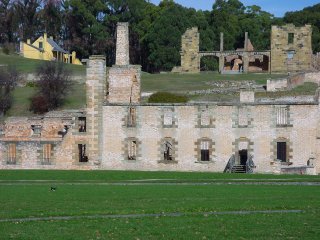 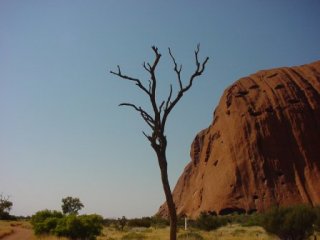
[Above Left] The Penitentiary #3, Port Arthur, Tasmania, Australia. (Photo by Coral Hull, 2000) [Above Right] Uluru #15, Uluru - Kata Tjuta National Park, Northern Territory, Australia. (Photo by Coral Hull, 2000)
Of course there are many other specific characteristics of paranormal activity that occur within a landscape that I have not mentioned here such as cold spots, wall rappings, footsteps, disappearing and reappearing objects, people being touched, voices and music that come from nowhere, the failure or 'odd behaviour' of electrical equipment such as lights and radios, showers and taps switching on and off on their own, objects moving of their own accord, the reaction of animals and children to phenomena etc. Whilst I have actually experienced some of the above my focus in photographing Australia's haunted landscapes is to record the general nature of the haunted landscape from a creative perspective, rather than from any specific investigation of paranormal activity. Whilst I believe in a landscape that is multi-dimensional, the above points would suggest that it is human imagination rather than any actual physical phenomenon existing outside human imagination that is at work. If everything left an imprint might not a landscape be haunted by a wheatcrop and might we not see a cloud that existed before but not now? Should not the whole sky be haunted by previous sunsets and the landscape be haunted by millions of species of flora and fauna?
There are a few exceptions to the rule regarding the nature of a haunted object. For example: an object taken from a haunted landscape may carry with it the characteristics of that landscape and hence create a series of events similar to that haunted landscape, if removed from an old environment and taken into a new environment. This would suggest that either human imagination perceives an object as being haunted and hence reacts to this suggestion, or that in fact the objects carry their own energy and are either inhabited or possess consciousness. An example of a specific object being haunted is when the door knocker was taken from the Monte Cristo homestead in Junee and returned after the 'borrowers' kept hearing knocking on their door to which the Monte Cristo knocker had been attached. There are numerous stories regarding Uluru (Ayres Rock) in Central Australia which is a sacred area to indigenous Australians (Mititjulu Community) in the area and which is thought to retain the energy of ancestral beings. Many park rangers and other staff who work at the Uluru-Kata Tjuta National Park tell stories of small pieces of rock being returned in envelopes after the people who have taken them reported hauntings and bad luck. My ex-partner had his own story from the 1970's when a teacher from a school excursion took some rock and decided to post it back to Sydney in New South Wales, 4,000 kms south east, rather than carry it back on the bus. Apparently the mail truck that was transporting the piece of rock from Uluru overturned on the Stuart Highway and as a result the rock never made it back the the classroom in Sydney. 'Believe it or not?!'
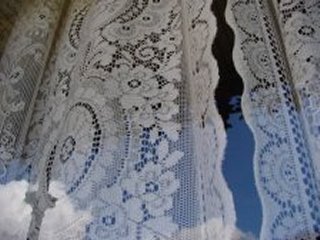 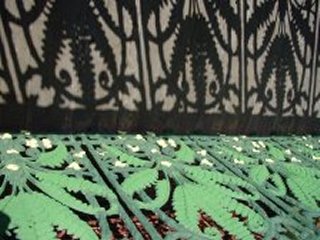 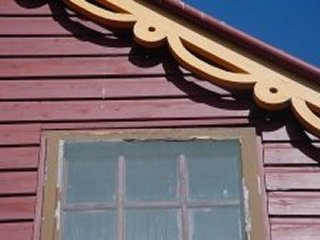
[Above Left to Right] Dining Room Window, Monte Cristo Historic Homestead, Junee, New South Wales, Australia. (Photo by Coral Hull, 2001) Verandah, Monte Cristo Historic Homestead, Junee, New South Wales, Australia. (Photo by Coral Hull, 2001) Prayer Room Window, Monte Cristo Historic Homestead, Junee, New South Wales, Australia. (Photo by Coral Hull, 2001)
I believe that a haunted landscape is similar to an ecosystem in regard to its diversity, but in matters of a psychic nature rather than a physical nature. What an ecosystem and a haunted landscape have in common is that both remain largely unseen or unknown to the human psyche. The attempt to discover psychic phenomena or layers of paranormal activity can be likened to discovering a new species of frog in a tropical woodland. Hence NT Field Naturalists Club and the Australian Ghost Hunters' Society may have more in common than they think! I am interested in making these types of connections through photographic interpretation, as a series of emerging moments within a particular landscape, that enable me to think more about and record that landscape in a different way to the way that I normally would. I am not seeking to prove the existence of ghosts, but rather to record subtle shifts in perception that might occur within my own mind during a process of creative interpretation and in particular photographic documentation. Whilst I believe in the existence of haunted places that may involve specific manifestations and/or overall unexplained supernatural activity, I approach the area as an agnostic and a creative artist, rather than as a ghost hunter or paranormal investigator.
It has been very interesting to note that many haunted landscapes throughout Australia follow similar codes of existence and that a large number of ghost stories are similar in content. The state of New South Wales, for example, probably due to it being the oldest colony in Australia, and with the largest population, lays claim to some of Australia's most haunted places. Some of these include Sydney's Hyde Park Barracks, Quarantine Station and the infamous pioneer homestead, Monte Cristo. Other places include the Prince Henry Hospital, Queen Victoria Building, The Rocks, The Opera House and the Picton tunnel in Sydney's outer west. Most of these places now run their own ghost tours. Ghost tours have recently become popular in Australia with the owners or caretakers of such places now making their money by running historical tours during the day and ghost tours at night - perhaps when the earth's magnetic fields are quieter and when the human mind is more susceptible to matters of a ghostly nature! To me it would seem as if a haunted place is operating on a number of different psychic levels. I believe that we can put an alleged 'haunted landscape' down to both the human imagination and actual physical or paranormal activity. A haunted area is an area beyond the so-called natural and readily explained. It is the supernatural. It was during a recent weekend away at Junee spent photographing the Monte Cristo homestead particularly inspired me to look deeper into my fascination with haunted places.
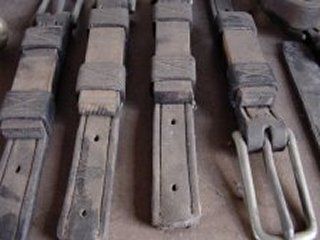 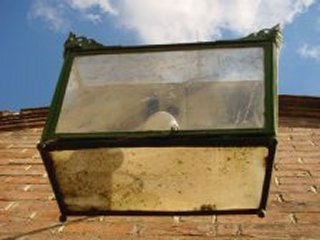 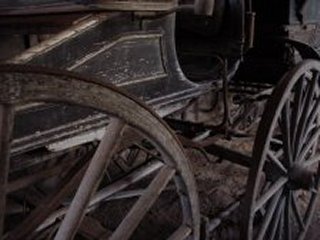
[Above Left to Right] The Stables, Monte Cristo Historic Homestead, Junee, New South Wales, Australia. (Photo by Coral Hull, 2001) Outside Light, Monte Cristo Historic Homestead, Junee, New South Wales, Australia. (Photo by Coral Hull, 2001) The Stables #2, Monte Cristo Historic Homestead, Junee, New South Wales, Australia. (Photo by Coral Hull, 2001)
The difficulties in photographing Monte Cristo was something I had not experienced before, either as part of my photographing or in a landscape of any description. After spending a few solid hours photographing the outside of the homestead and surrounding gardens, I carefully approached the front windows and looked inside. The big white clouds and rolling countryside that is characteristic of New South Wales was swimming in the window glass. In stark contrast the hallway of the homestead was darkly lit by a red light which reminded me of a brothel I had visited in Surry Hills in Sydney. The windows of the homestead appeared primarily at the front and back of the building with the side walls occupied by fireplaces. The homestead would keep a consistent temperature during the weather extremes of Junee, through its sixteen inches of brick. Whilst inside the homestead itself, the atmosphere remained in a semi twilight, a world inhabited by unexplained paranormal activity and filled to the brim by the owners with good quality antiques.
Tours of the Monte Cristo homestead in Junee in New South Wales are run daily by the Ryan family, who also use all the rooms as part of their daily living. The first question to come to mind was: can an environment be haunted without the presence or intervention of human beings? Whatever the answer, there have at least been various sightings of spectral cattle in Australia, with a good example being near Camden in New South Wales. One would assume that the cattle would appear with or without the human witnesses (See The Ghost Guide to Australia by Richard Davis). Throughout my photographing of the outside areas of the Monte Cristo homestead, I remained vaguely disturbed and generally dissatisfied by the experience. I couldn't seem to make the connection to the place in order to start the process of interpretation. Whilst I normally obtain by best photos on a spur of the moment decision or during a short time period, I had to go back a second and third time in order to properly photograph the Monte Cristo homestead, in particular the spooky interior.
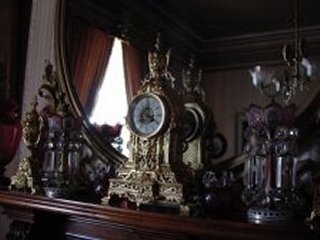 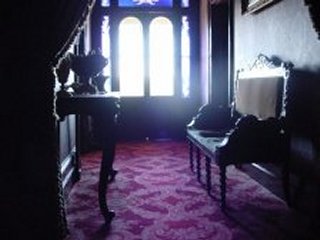 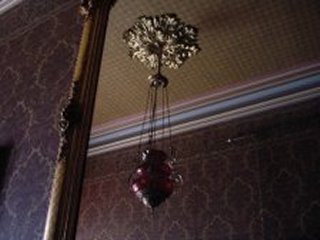
[Above Left to Right] The Sitting Room #2, Monte Cristo Historic Homestead, Junee, New South Wales, Australia. (Photo by Coral Hull, 2001) Upstairs Hall, Monte Cristo, Historic Homestead, Junee, New South Wales, Australia. (Photo by Coral Hull, 2001) Downstairs Hall Light, Monte Cristo Historic Homestead, Junee, New South Wales, Australia. (Photo by Coral Hull, 2001)
I would like to briefly describe a few of my experiences at Monte Cristo during this weekend of initial observation and photographing. My partner Iain and I drove down from Sydney which is about four hours north-east of the town of Junee in New South Wales. We arrived after dark and I had fallen asleep in the car. The minute the car stops I usually wake up. This time I remained asleep in a kind of dream paralysis. I was trying to wake myself up, but was dreaming of the haunted rooms inside the homestead of Monte Cristo. During the dream the various rooms were making themselves known to me and seemed to be calling me into themselves. It was not a particularly pleasant invitation, rather a weird and intense one. I pushed myself into consciousness and woke up with a start! I realised that I had been having a lucid dream which obviously involved some unresolved fears regarding the project. I began to feel anxious but dismissed the dream as simply a fear of the unknown. Interestingly enough I am only able to photograph haunted landscapes on an irregular basis due to their psychological impact on me.
In the morning I could see that the homestead of Monte Cristo was built up on a hill overlooking Junee (aboriginal for Jewnee meaning: speak to me) and almost directly parallel to the Motor Inn we were booked into. The homestead certainly had an atmosphere or intensity about it, even as viewed from the Junee township, and the closer we got the more that intensity was apparent, at least to myself. I was very uncomfortable even when some distance away from the homestead. In the past local residents have seen light streaming from all the windows and doors of Monte Cristo, when there was no electricity connected to the house! On first moving into the homestead Reg and Olive Ryan had returned from town one evening where they had gone to buy supplies. As they turned the car into the bottom corner of the driveway and straightened it up towards the house, they saw bright lights streaming out of every window and door and into the surrounding fog. There was no electricity in the house at the time. As they drove into the driveway the lights disappeared.
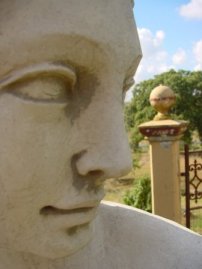
|
A second incident occurred to me when I was photographing the outer buildings of the property. There were some very painful things that had happened to past residents at some of those locations, including a young employee who had accidentally burnt to death in the stables and a mad man who had been chained to a wall for many years.
When the incident occurred I was walking along the verandah of the old homestead, which had eventually become the servants' quarters and kitchen to the newer homestead, and looked into a window where I saw three other tourists. I thought, this bloody place is full of tourists, shrugged it off smiling to myself and walked into the outbuilding with my camera intending to say hello. However once I had entered there was no one inside but the antique displays and a solitary mannequin in a black frock. |
[Above] Marble Statue, Monte Cristo Historic Homestead, Junee, New South Wales, Australia (Photo by Coral Hull, 2001)
I knew almost immediately that I had experienced some kind of hallucination conducive of the place. I walked back out onto the verandah in order to try and reinvent what had just happened and to see if I had mistaken the mannequinn and shadow play for the actual tourists, but when I looked into the window again, I saw that it was covered over with a curtain. Hence not only weren't the tourists inside, but I couldn't have seen inside the servants' quarters at all! A few more slips of the imagination occurred throughout the ghost tour the following night. This time I chose not to take my camera with me, but instead to simply take in the atmosphere in an attempt to make some kind of connection with it in order to start the documentation process.
While on the ghost tour I saw a few things out of the corner of my eye, including what I thought was the previous owner. These things are easily put down to the imagination. However I was part of a group that experienced an unexplained sound in the Breakfast room downstairs. It appeared to be coming from a corner of the room at knee level and then bounced into two different locations. It sounded like a coffee percolator to me and like the low resonance of moving crockery to my friend. But none of us could be sure. It was then suggested that it might be the vibrations of the people walking around upstairs. However this was quickly discounted by Reg Ryan's brother-in-law Peter, who said that a huge bed was directly overhead so no one would be walking there. He had not heard the sound before and neither could he explain it.
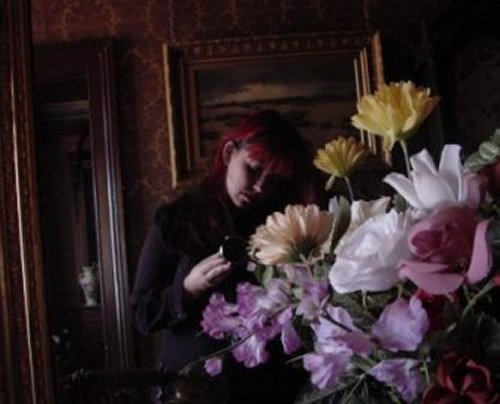
[Above] Self Portrait #40, Monte Cristo Historic Homestead, Junee, New South Wales, Australia (Photo by Coral Hull, 2001)
What made the sound odd was the quick shift in location, which occurred from corner to corner and then appeared to be in the middle of the room, until it wasn't able to be accurately pinpointed by anyone present. A number of people heard this and the owner Reg Ryan had no explanation when I spoke with him about it the next day. He said things like that happen all the time. He showed the group how he had just lit up twenty candles and for some unexplained reason one of those candles burnt completely through within minutes whilst the others remained basically intact - a single faulty candle? Who knows? The first ghost tour run by the Ryan family was a success both from a historical perspective and on a supernatural level, with a few psychics trying their hand at some serious interpretation and the homestead's rooms maintaining their odd atmospheres for all those present. Monte Cristo is said to presently attract over 2000 ghost hunters per year. I went away that night unsatisfied. I had not been satisfied with many of my photos from during the day from outside the house and couldn't figure it out.
On Sunday morning I knew that I had to go back to the house yet again for photographs. My best photos are taken quickly and more so during a first shoot. It is very unusual for me to feel the need to perpetually return. What I had figured out on Sunday morning was that the house was actually repelling me. Thus it wasn't simply a matter of photographing another historical site. At Monte Cristo there appeared to be other forces at work. I was stuck on this thought for about an hour until I came to the conclusion that the house was very unfriendly and didn't want people (including photographers) inside. It took me almost the entire weekend to come to this conclusion, mainly because the owners and staff were so friendly, and I didn't want to offend them by saying anything negative in regard to my experience at the homestead. Nevertheless when I knocked on Reg Ryan's door that morning at 10.00 am he came out and I said I was back again for more photographs. I said that the house had been repelling me and that I was unable to take any photos that I was really satisfied with. Many would have thought that I was a touch shy from the sun or simply a bad photographer who didn't know it. However Reg knowingly laughed and said that a lot of people's cameras actually break or the film doesn't turn out. This made me feel a little bit less foolish. I was also told that many people thought the house was evil and refused to go in, or that once they had gone inside they left soon afterwards, never to return.
I rarely take indoor photographs, but I felt a need to go back into the homestead and attempt the inside shots that I hadn't wanted to take before. Reg told me to meet him around the front, where he let me in. The next hour was spent walking (or hiding) behind my camera lens. Reg Ryan popped in a few times to see how I was doing. I couldn't hide my nervousness and we spoke about the previous inhabitants and the tour from the night before. He finally left me to it for the next hour which at first I admit I wasn't too happy about. I felt a distinct uneasiness inside the homestead that I was unused to.
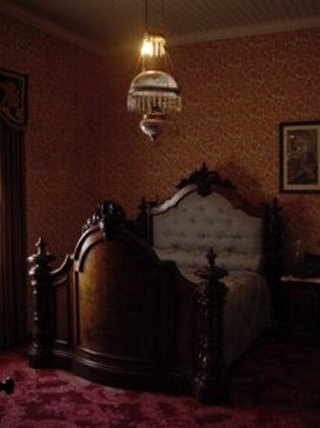
|
I have photographed disturbing subject matter in the past, but the reaction has been one of empathy and hence the experience of pain, rather than fear - or at least the kind of fear I was experiencing as a result of being here.
In between Reg Ryan's departure and the first historical tour for the day, I was basically left alone in Australia's most haunted house for one hour. During the photographing session I found myself speaking out loud and quietly apologising if I accidentally touched anything, or brushed against something, mainly in order to ease my fear. Perhaps it was also a way of placing my presence in a situation that seemed ominous and even hostile on an unconscious level.
For the whole time I photographed the interior of the homestead, I felt like I was not alone. Reg's wife Olive sums my feelings up when she says: 'there are two families living in the house of Monte Cristo. They can't see us and we can't see them'. Olive still does not like to be left alone during the day at the house and has, along with the rest of her family, had her share of ghostly experiences over the years. |
[Above] The Boy's Room, Monte Cristo Historic Homestead, Junee, New South Wales, Australia (Photo by Coral Hull, 2001)
I photographed downstairs rooms first - sitting room, dining room, breakfast room and the upstairs hall. My main concern was the play of morning light from windows and inside the old mirrors. Many of the crystal vases were made and then bought and placed in order to capture light in what is actually a very dark house. I was attracted to this. The homestead is facing towards the east so the morning was a good time to be inside photographing the rooms. I had also deliberately chosen the morning in which to do my work, as I do not believe I would have been able to be in the rooms alone during the night. After my initial nervousness had begun to dissipate, my mood seemed to sink into the general atmosphere of the homestead and I became very tired. I also begin to think that perhaps I was as haunted as the house itself.
Had I come here to discover something about my own psyche which I believed was reflected by the landscape? I started to think about what it was that actually motivated me to explore these haunted landscapes, whilst I continued to focus my camera on angles and light within the rooms. I seemed to look very haggard inside the mirrors. After a while it was almost as though the homestead began to take pity on me, as perhaps I did on it. Thus it was in this quiet way that some kind of relationship was finally established between myself and old Monte Cristo. After this realisation I took a series of self-portraits, primarily to observe the homestead's effect on me. I then ventured upstairs into the most haunted areas and very carefully proceeded to document them, starting with the well known 'boy's room' where many people had experienced ghostly-goings-on over a period of years. I mean, talk about all my nerves being on edge!
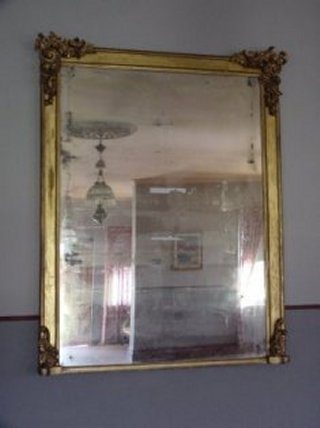
|
As the hour wore on, I was beginning to feel a little more confident. Yet I still hoped that nothing sudden would happen. It was not the type of place where you could fully relax no matter how long you stayed. I also recognised that this process of creative interpretation made me less afraid, as if having a camera between myself and the subject matter somehow distanced me from it. You could say I kept moving and kept the film rolling without much pausing. As the hour wore on and my memory stick was quickly filled up with images, I became calmer, perhaps relieved that the job was almost completed.
In the end I liked the old homestead and felt a genuine sympathy for it, despite its obvious nature of repellance and general unfriendliness. The whole time I photographed I sensed a reality aside from the one that was being photographed. This may have been panic or disassociation on my part, but I wasn't sure. Did haunted landscapes possess multiple psychic layers or unrecognised dimensions? Surely all landscapes were haunted in some way or another and, if they were, why were people specifically focused on certain areas and not others? |
[Above] Ballroom Mirror, Monte Cristo Historic Homestead, Junee, New South Wales, Australia. (Photo by Coral Hull, 2001)
Reg Ryan believes that he was originally driven to buy and live at Monte Cristo through the intervention of supernatural forces. It appeared to be his purpose in this life to restore the dilapidated homestead to its former glory and then spend a lifetime dedicated to looking after it. In my opinion you would have to admire a man who has such passion for such an intense and foreboding environments and also his dedicated wife Olive and their children for making the choice to live there with him and the 'others'. I have come away from my experience with much respect for Reg and Olive Ryan, the faithful caretakers of the Monte Cristo historic homestead. As for the house itself, no fond feelings will be lost between us.
Monte Cristo has not been my first experience with regard to haunted houses. As a child I believed that our house at Rose Street in Liverpool on the outer western suburbs of Sydney was haunted. There appeared to be a dark sinister feeling coming from my mother's bedroom that made me afraid of the dark. The house was also built on underground sewerage. Often girlfriends would stay over and freak out. Once a psychic came over and said that the bedrooms were particularly bad and chose to visit my mother in the backyard, not wanting to go into the house for a second time. My mother used to say that she felt a very creepy presence in her bedroom, a kind of shadowy figure that used to sit on the end of her bed. She said that she felt the indentation of the mattress and her legs being touched. She said that it used to wake her up out of sleep - no, it was not my father. As a child I would often hear heavy sets of footsteps coming up the hallway towards my bedroom. Were they merely shifting floorboards, my childhood imagination working overtime, my own heart beating or something else?
When my parents got divorced we left Rose Street and moved into a townhouse a few streets away. My mother's bedroom furniture, which a number of people said that the problem came from, was brought with us and perhaps the energy followed us as well. One night I was on my stomach drifting into sleep and I felt all the sheets in my bed moving up around my shoulders and neck. I was definitely awake at the time and couldn't believe what was happening! Whatever it was, was trying to tuck me into bed! I ran from the bedroom and was unable to sleep there for many nights. The phenomenon lasted for around fifteen seconds and was followed by a cross between a shriek and a chuckle in the centre of the room. Over the years I have had my share of encounters with the unexplained which have appeared more physical than psychological in origin. Each of these landscapes has allowed a new insight, not only from a human perspective or interpretation of its atmosphere and happenings, but also into the unknown psychology of the haunted area itself and the many different levels that its existence is operating under.
About the Writer Coral Hull
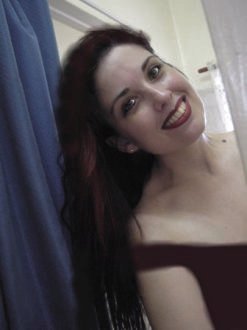
|
Coral Hull is the author of over 35 books of poetry, prose poetry, fiction, artwork and digital photography. Born in 1965 she was raised under disadvantaged circumstances in the working class suburb of Liverpool in Sydney's outer west. Coral became concerned with issues of social justice and spirituality from an early age. She wrote her first poem about a rainforest at age 13. Coral became an ethical vegan and an animal rights advocate who has since spent much of her life working voluntarily on behalf of animals and the environment, both as an individual and for various non-profit organisations. She is also the Executive Editor and Publisher of Thylazine; an electronic journal featuring articles, interviews and visual art of Australian poets, writers, artists and photographers. Coral holds a Master of Arts Degree in Creative Writing from Deakin University in Victoria. She also holds Doctor of Creative Arts Degree (Creative Writing Major) from the University of Wollongong in New South Wales. An extensive biography, list of publications, festivals, interviews, articles and reviews can be found online. Coral currently lives in between Darwin (NT) and Sydney (NSW), with her two dogs Binda and Kindi. |
[Above] Coral Hull, Elliot Hotel, Elliot, Northern Territory, Australia (Photo by Coral Hull, 2001)
I Next I
Back I
Exit I
Thylazine No.5 (March, 2002) |



